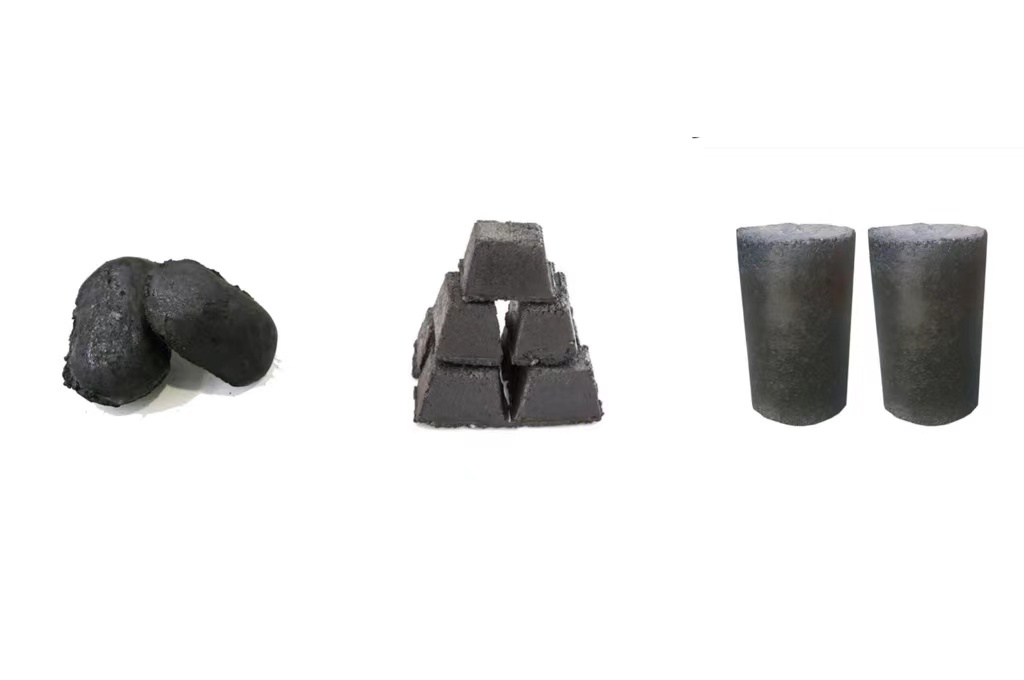Karbon elektrot macunu nedir?
Elektrot macunukendinden pişirme elektrodu olarak da bilinen, ferroalyaj fırınları ve kalsiyum karbür fırınları gibi elektrikli fırın ekipmanlarında kullanılan iletken bir malzemedir.
Çeşitli şekiller içerir: silindirik, çakıl, blok vb. Müşteri ihtiyaçlarına göre farklı kalıplar kullanılarak farklı boyutlarda yapılabilir.
İçindekiler
GeçişBlok elektrot macunu: 60x80x100 mm
Çakıl elektrot macunu: 50x100mm
Kolon elektrot pastası: Ø500, Ø600, Ø700, Ø800, Ø900, Ø1000
Uygulama:
Karbon elektrot macunu esas olarak pik demir, ferroalaşımlar, silikon, sarı fosfor ve kalsiyum karbür vb. üretiminde kullanılır. Elektrotlar bir elektrikli fırında sürekli olarak kendi kendine pişirilir ve pişirmeyi tamamlamak için cevher fırınındaki ısıya dayanır. Bu nedenle, elektrot tüketim oranını kavurma oranıyla eşleştirmek elektrot macunu kullanımının anahtarıdır.
Cevher yakıtlı fırın teknolojisinin gelişmesi nedeniyle, yavaş yavaş büyük ölçekli ve kapalı yönlere doğru gelişmiştir. Kavurma işlemi sırasında elektrot, geçmişteki açık fırın tipinden daha az iletken ısı ve radyan ısı elde etmiş ve sadece iletken ısı elde edilmiştir.
Bu nedenle, elektrot tarafından fırından elde edilen ısı miktarı büyük ölçüde azalır. O halde bu eksikliği telafi etmek için elektrot hamurunun sinterleme performansını iyileştirmek gerekir.
Türleri:
Karbon elektrot macunu türleri temel olarak standart elektrot macunu ve kapalı macunu içerir.
Standart elektrot macunu esas olarak açık kalsiyum karbür fırınlarında kullanılır. Hammaddeleri arasında sıradan kalsine antrasit ve metalürjik kok bulunur ve bağlayıcı olarak orta sıcaklıkta asfalt kullanılır. Bu elektrot macunu yüksek kül içeriği, yüksek direnç, yavaş sinterleme hızı, ancak düşük fiyat ile karakterizedir. Açık ferroalyaj fırınları ve küçük ve orta ölçekli kalsiyum karbür fırınları gibi geleneksel açık fırın tipleri için uygundur.
Kapalı pasta esas olarak kapalı ferroalyaj fırınlarında, kalsiyum karbür fırınlarında ve diğer metalurjik fırınlarda kullanılır. Hammaddeleri arasında antrasit, grafit parçaları ve petrol koku bulunur ve düşük yumuşama noktalı bir bağlayıcı kullanılır. Standart elektrot pastası ile karşılaştırıldığında, iyi elektriksel ve termal iletkenlik, düşük kül içeriği, hızlı sinterleme hızı ve yüksek fiyat özelliklerine sahiptir.
Bu iki tip elektrot macununun üretim süreci benzerdir. Bunlar temel olarak hammadde kalsinasyonu, kırma, eleme, öğütme, yoğurma ve kalıplamayı içerir. Kendiliğinden pişen elektrotun hammaddesi olarak elektrot macunu, elektrot fırınının çalışmasında gerçekleştirilir. tozaltı ark ocağı. Dolayısıyla, üretim süreci kavurma ve ardından grafitleştirmeyi içermez.
Sonuç:
Elektrot macununun üretim süreci, esas olarak hammadde kalsinasyonu, kırma, eleme, öğütme, yoğurma ve kalıplama dahil olmak üzere diğer karbon malzemelerin hazırlama sürecine benzer. Kendiliğinden pişen elektrotun hammaddesi olarak elektrot macunu, tozaltı ark ocağının çalışmasında gerçekleştirilir. Dolayısıyla üretim süreci kavurma ve ardından grafitleştirmeyi içermez. Bu malzemenin kullanımı sadece endüstriyel üretimde önemli bir rol oynamakla kalmaz, aynı zamanda yerli elektrot macununun yüksek kaliteye doğru gelişimini de teşvik eder.

